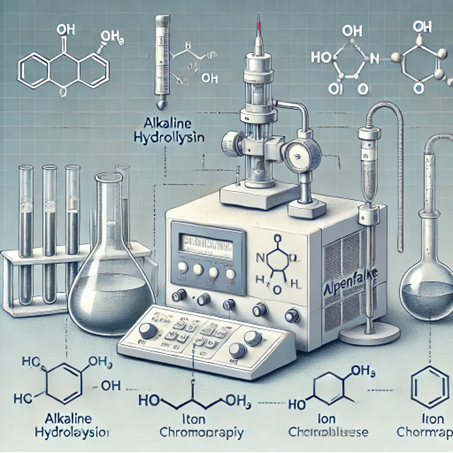Determination of Nitrogen Content in Nitrocellulose: Advanced Methods and Applications
Nitrocellulose, a nitrated cellulose ester polymer, is a cornerstone material in a variety of industries, spanning from pharmaceuticals to explosives. One of its defining features is its nitrogen content, which plays a pivotal role in determining its chemical properties and end-use applications. High nitrogen content nitrocellulose is predominantly used in the manufacturing of explosives and gun propellants, while lower nitrogen variants find applications in coatings, adhesives, and printing.
This blog explores a novel method for determining the nitrogen content of nitrocellulose derived from smokeless gunpowders and collodions. By leveraging alkaline hydrolysis followed by ion chromatography, this method offers accuracy, speed, and efficiency, making it a viable alternative to traditional techniques.
Importance of Nitrogen Content in Nitrocellulose
Nitrogen content in nitrocellulose is critical for several reasons:
- Defining Applications: Fully nitrated nitrocellulose, with a nitrogen content around 14.1% by weight, is used in high-energy explosives. Variants with nitrogen content below 12.5% are employed in industrial products like varnishes and inks.
- Quality Control: Particularly in military applications, the nitrogen content directly impacts the ballistic properties of propellants. Thus, stringent quality checks are essential.
- Aging and Decomposition: Over time, nitrocellulose can lose nitro groups, affecting its performance. Periodic nitrogen content analysis helps assess material stability.
Traditional Methods for Determination
Historically, the determination of nitrogen content in nitrocellulose involved digestion and titration methods. For example:
- Digestion/Titration Method: Widely used in Spain, this involves isolating nitrocellulose, followed by treatment with concentrated sulfuric acid. Potentiometric titration then measures the resulting nitric nitrogen. While accurate, this method is labor-intensive, requiring about three days to complete.
- Automated Analytical Methods: Developed by organizations like the U.S. Army Toxic and Hazardous Materials Agency, these involve complex processes such as dialysis, hydrolysis, and diazotization, followed by spectrophotometric analysis. Despite automation, these methods remain time-consuming and require skilled operators.
Challenges with Traditional Methods
- Time-Consuming: Conventional methods often require days to yield results, making them unsuitable for frequent testing.
- Skill-Dependent: Accuracy heavily relies on the expertise of the operator.
- Complexity: The use of hazardous chemicals like concentrated sulfuric acid poses safety risks.
Alkaline Hydrolysis and Ion Chromatography: A Modern Approach
Recent advancements propose using alkaline hydrolysis followed by ion chromatography for nitrogen content determination. This method simplifies the process and improves efficiency.
Principles of the Method
- Alkaline Hydrolysis:
- Nitrocellulose is hydrolyzed using sodium hydroxide (1.0% NaOH) at 150 °C for 30 minutes.
- The reaction cleaves nitro groups, forming nitrate and nitrite ions.
- Ion Chromatography:
- The hydrolysate is analyzed using ion chromatography with conductimetric detection.
- Concentrations of nitrate and nitrite ions are determined.
- Nitrogen content is calculated based on ion concentrations.
Advantages of the Proposed Method
- Speed: The total analysis time, including nitrocellulose isolation, hydrolysis, and chromatography, is approximately four hours—ten times faster than traditional methods.
- Accuracy: The method demonstrates high precision, with errors ranging from 1% to 15.2% when compared to official labels. Higher errors for older samples are attributed to nitro group loss during aging.
- Safety: Eliminates the need for concentrated sulfuric acid, reducing safety hazards.
- Adaptability: Applicable to both gunpowders and collodions, expanding its utility.
Detailed Procedure
Sample Preparation
- Gunpowders:
- Nitrocellulose is isolated using a protocol developed by research groups to remove other nitrogen-containing components like nitroglycerine and dinitrotoluene.
- Collodions:
- As liquid preparations, these samples can be directly subjected to hydrolysis without prior isolation.
Hydrolysis
- The nitrocellulose sample is mixed with 1.0% NaOH.
- Heated to 150 °C for 30 minutes in a sealed environment to prevent loss of volatile components.
Ion Chromatography
- The hydrolysate is injected into the ion chromatograph equipped with a conductivity detector.
- Suppression techniques are employed to enhance detection sensitivity.
- Nitrate and nitrite ion concentrations are quantified.
Calculations
- The nitrogen content is derived using established stoichiometric relationships between the ions and nitrocellulose.
Application to Gunpowders and Collodions
Gunpowders
- Analysis of single-base and double-base gunpowders (manufactured between 1944 and 1997) revealed variations in nitrogen content.
- Older samples exhibited higher errors due to nitro group degradation over time.
- This method provides insights into the aging process of gunpowders, aiding in storage and usage decisions.
Collodions
- While labels for collodion samples do not specify nitrogen content, the method offers reliable measurements, ensuring product consistency for industrial applications.
Broader Implications
Military Applications
- Regular monitoring of nitrocellulose nitrogen content ensures consistent ballistic performance.
- The method supports quality assurance in the production of explosives and propellants.
Industrial Applications
- Manufacturers of varnishes, adhesives, and inks can implement this method for batch quality control.
- The method’s speed and accuracy make it suitable for high-throughput industrial environments.
Environmental Impact
- Alkaline hydrolysis offers a pathway for environmentally friendly disposal of nitrocellulose waste by breaking it down into less harmful components.
Comparison with Other Methods
| Feature | Digestion/Titration | Automated Analytical | Alkaline Hydrolysis/Ion Chromatography |
| Time | ~3 days | ~1 day | ~4 hours |
| Accuracy | High | High | High |
| Safety | Low | Moderate | High |
| Complexity | High | High | Low |
| Applicability | Limited | Limited | Wide |
Conclusion
The determination of nitrogen content in nitrocellulose is crucial for quality assurance across industries. The proposed method, utilizing alkaline hydrolysis and ion chromatography, presents a significant improvement over traditional approaches. Its efficiency, accuracy, and adaptability make it an invaluable tool for manufacturers, military applications, and environmental management.
This innovation not only accelerates analytical processes but also ensures safer and more sustainable practices, paving the way for broader adoption in laboratories worldwide.

